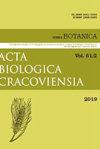亲缘林种凤梨与石竹自然杂种ISSR标记的可加性
IF 0.5
4区 生物学
Q4 PLANT SCIENCES
引用次数: 6
摘要
杂交物种和亲本物种在相似生态位上的共存,对性状可加性和过分散(新性状的出现)在微进化过程中的作用提出了疑问。基于分类群基因组的非编码区(ISSR遗传指纹图谱),分析了该物种在欧洲同域和异域分布部分的贝内氏帚帚帚、长尾帚帚帚和自然杂交的贝内氏帚帚帚×长尾帚帚的遗传多态性。我们测试了7个种群的68个个体,包括法国北部的一个杂交种群。共获得233个ISSR多态性条带(位点)。结果表明,亲本种具有明显的遗传差异,杂种具有亲本种ISSR带的加性模式(NMDS, STRUCTURE);然而,有证据表明,有向长尾白蚁(NEWHYBRIDS, UPGMA分类,Nei’s D遗传距离)的渐近。同源Bromus benekenii有72个条带,同源Bromus ramosus有21个条带,杂交Bromus有9个条带(遗传过度分散),这可能是基因组重排的结果。杂种群体的遗传分化指数DW较低,似乎处于较年轻的阶段。我们认为,面对有利于次生接触的人为景观变化,杂交物种可能会在同域地区竞争性地取代亲本物种。遗传可加性,杂交带,渐渗,ISSR,林奈分类,微进化。本文章由计算机程序翻译,如有差异,请以英文原文为准。
Additivity of ISSR markers in natural hybrids of related forest species Bromus benekenii and B. ramosus (Poaceae)
The co-occurrence of hybrids and parental species in similar ecological niches poses a question on the role of traits additivity and overdispersion (emergence of new traits) in microevolutionary processes. We analysed genetic polymorphism of Bromus benekenii , B. ramosus and the spontaneous hybrid B. benekenii × B. ramosus in sympatric and allopatric parts of the species distribution in Europe, based on non-coding regions of the taxon genomes (ISSR genetic fingerprinting). We tested 68 individuals in 7 populations, including a hybrid population in N France. Altogether 233 polymorphic ISSR bands (loci) were obtained. We found that the parent species were genetically distinct and the hybrids had an additive pattern of ISSR bands found in the putative parental species (NMDS, STRUCTURE); however, there was evidence of introgression towards B. ramosus (NEWHYBRIDS, UPGMA classifications, Nei's D genetic distance). Bromus benekenii had 72, B. ramosus 21 and the hybrids 9 private bands (genetic overdispersion), probably resulting from the rearranged genomes. Based on its low genetic divergence index DW, the hybrid population seems to be at a young age. We argue that in the face of anthropogenic landscape transformations favouring secondary contacts, the hybrids may competitively replace the parental species in sympatric areas. KKeeyy wwoorrddss:: Genetic additivity, hybrid zone, introgression, ISSR, Linnaean taxonomy, microevolution.
求助全文
通过发布文献求助,成功后即可免费获取论文全文。
去求助
来源期刊
CiteScore
3.00
自引率
0.00%
发文量
0
审稿时长
>12 weeks
期刊介绍:
ACTA BIOLOGICA CRACOVIENSIA Series Botanica is an English-language journal founded in 1958, devoted to plant anatomy and morphology, cytology, genetics, embryology, tissue culture, physiology, biochemistry, biosystematics, molecular phylogenetics and phylogeography, as well as phytochemistry. It is published twice a year.

 求助内容:
求助内容: 应助结果提醒方式:
应助结果提醒方式:


